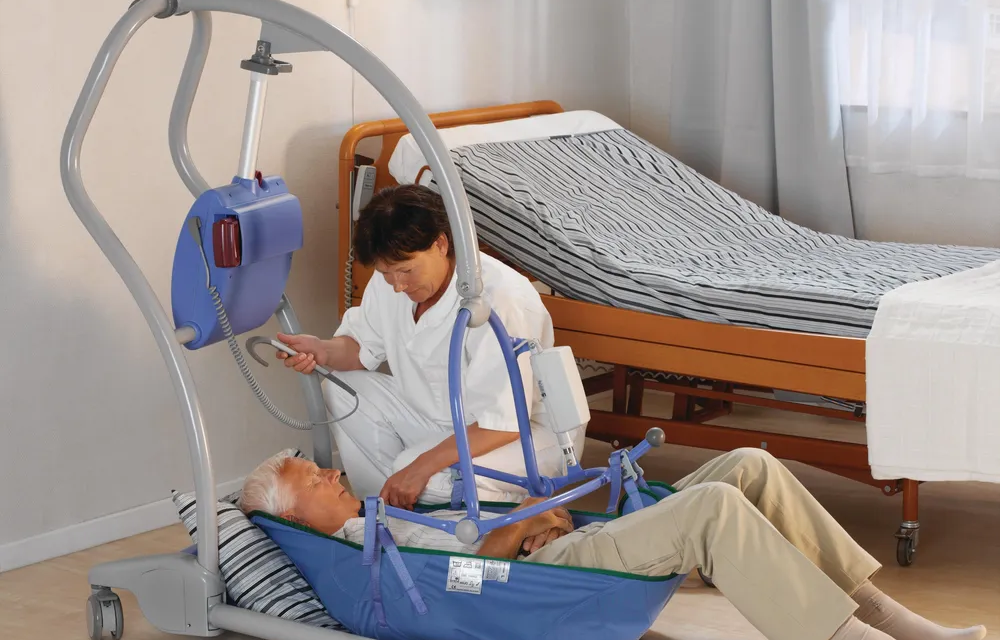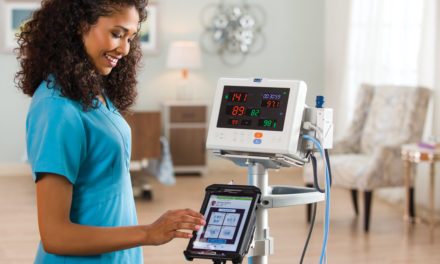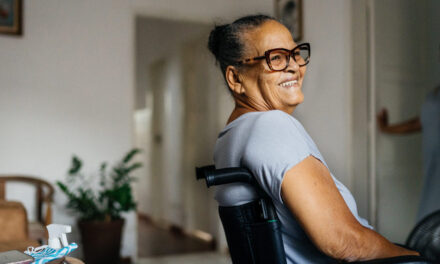Types of Patient Lifts
Non-Powered Stand Aids
- Non-powered stand aids are for patients who require minimal assistance
- Allows for quick and easy transfers
- Compact design
- Requires minimal training for staff
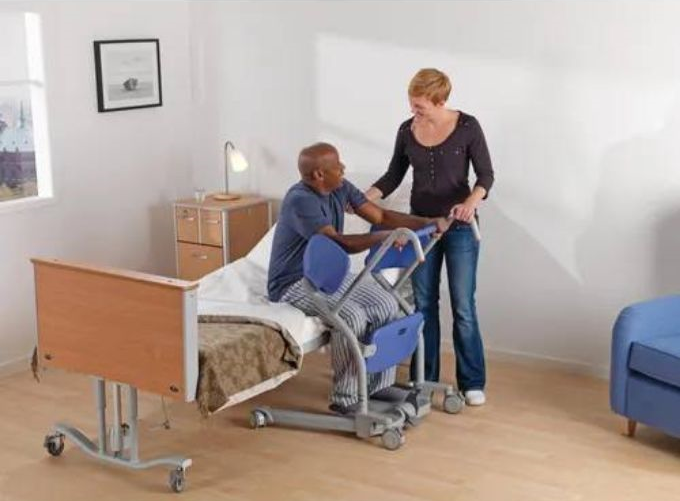
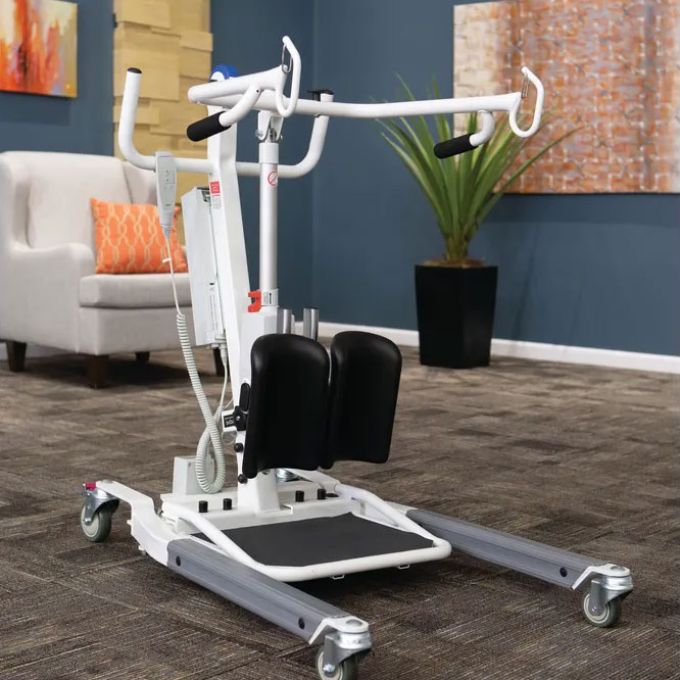
Sit-to-Stand Lifts
- Sit-to-stand lifts are for patients who demonstrate some weight-bearing ability or upper-body strength
- Ideal for use in patient rooms, toilet areas, bathing areas and common areas
- More dignified and conducive to patient involvement
- Easier and faster to use than floor lifts
- Small footprint for easy maneuvering in small areas
Floor Lifts
- Floor lifts are for patients who cannot support their own weight
- Ideal for lifting patients from the floor, beds, chairs, toilet/bathing areas and more
- Assists fallen patients off the floor
- Vertical style lifts patients straight up and down for easier positioning
- With the use of a scale, allows easy weighing of patients during lifting and transfer activities
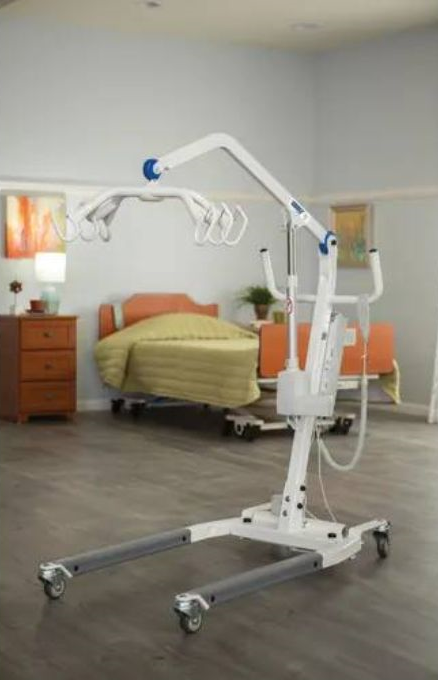
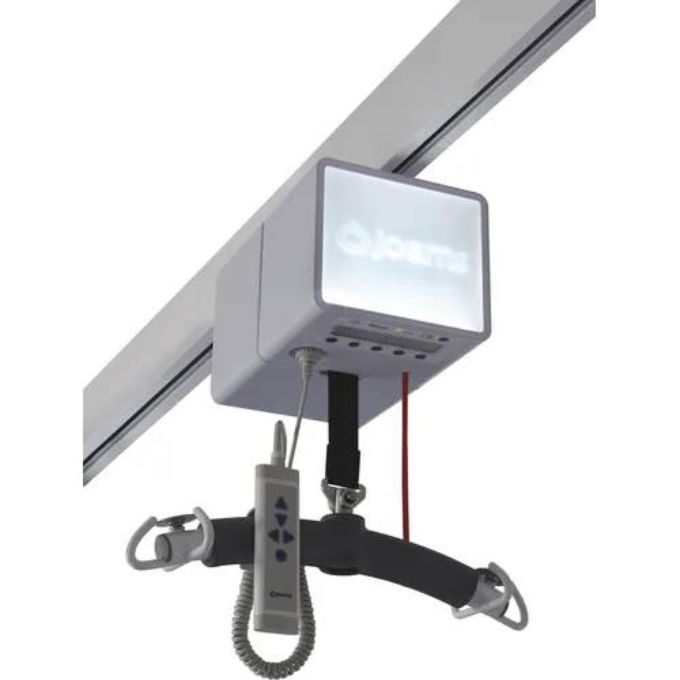
- Ceiling lifts are ideal for patient, therapy and tub rooms; can be permanent or portable
- Weight capacities up to 1,000 lbs.
- Reduces caregiver strain
- Offers expanded lift range
Key Factors in Choosing a Lift for Your Facility
Weight Capacity
- Higher weight capacities can accommodate a wider variety of residents
- As weight capacity increases, so does the size of the lift assist device
- Large lift size can limit usefulness in tight spaces, such as bathrooms
Base Widening (Powered vs Manual)
- Powered: requires the push of a button for the least amount of stress on the caregiver
- Manual: Hand-Shift Lever—the most potential to cause strain on caregiver, especially when there is weight in the sling
- Manual: Foot Pedal—uses the caregiver’s weight to widen the base, limiting back and shoulder strain
Base Clearance
- To maximize effectiveness, lifts should fit under existing beds
- For low beds, measure the underbed clearance and choose lifts with low base clearance
- Raising the bed forklift placement ensures staff work in a better position when applying or removing a sling
Range of Lift Height
- Floor lifts should reach low enough so patients who have fallen to the floor can be lifted up, and high enough to lift patients up to a high mattress height
- Often it helps to go up a sling size or two when lifting off the floor
Base Length & Width
- Shorter base lengths and widths allow lifts to maneuver in tight spaces
- The base should be wide open enough to fit around equipment and provide stability
Emergency Control
- All electronic lifts should have a control to stop the lift motor in case of an emergency
- Manual override allows residents to be safely moved in case of power loss
Gait Training
- Many patient lifts can also be used for gait training
- Boom height must be tall enough to accommodate the standing height of your patients
- If choosing a sit-to-stand lift, look for models with removable footplates to allow patients to stand comfortably between the base widening legs
Scale Attachment
- Allows caregiver to weigh residents during transfer, helping reduce incidence of caregiver injury
- Saves time and eliminates the need for an additional transfer to a scale
Transport vs Transfer
- Not all lifts are designed to move patients throughout your community
- Many lifts are intended for short-distance transfers, such as from a bed to a wheelchair.
- If you do a lot of long-distance moves, transport lifts can virtually replace the other transport equipment you use, such as stretchers or transport chairs.
Prioritizing safety: The advantages of safe lifting practices in your community
As acuities continue to rise and surveyors continue to cite F-Tag 323 (Accidents), it’s becoming increasingly important to establish and promote ergonomic and injury prevention programs.
Learning how to use sit-to-stand lifts and utilizing them correctly and consistently can play a key role in establishing a culture of safety within your healthcare facility. The proper use of senior lifts can significantly impact the safety of residents and staff, as well as enhance residents’ mobility, strength, and independence.
How to Enhance Resident and Staff Safety in Lift Transfers:
- Minimize lifting-related incidents and injuries
- Alleviate caregivers’ daily strain
- Lower insurance costs
- Improve care quality and resident outcomes
- Ensure safety for resident outcomes
- Boost staff recruitment and retention
- Increase community marketability (resident admissions)
- Control employee injury and malpractice expenses
Patient Lift FAQs
What is a patient lift?
A patient lift is a device designed to assist individuals with limited mobility in transferring safely and comfortably from one place to another, such as from a bed to a chair or from the floor to a bed.
Why are patient lifts important for senior care?
Patient lifts are crucial in senior care as they can help reduce the risk of falls and injuries for both patients and caregivers. They provide a safe and efficient way to transfer elderly individuals, enhancing their comfort and dignity.
Are patient lifts safe to use?
Lift assists for the elderly are designed with safety in mind. They often come with features such as emergency stop buttons, safety straps, and sturdy construction. Proper training on their use is essential to ensure safety.
Can patient lifts be used for lifting someone from the floor?
Many patient lifts, specifically floor lifts, are designed to reach low enough to lift patients from the floor. It’s important to choose a lift that can accommodate this function if needed.
How do I maintain a patient lift?
Regular maintenance includes:
- Checking for wear and tear on slings and straps
- Ensuring all mechanical parts are functioning properly
- Charging batteries for electric lifts
- Cleaning the lift according to the manufacturer’s guidelines
Direct Supply® makes finding the right patient lifts easy
When it comes to patient lifts, we know there are many choices on the market today and finding what’s best for your facility can be a challenge. That’s why Direct Supply offers an assortment of the top brands in one convenient place. Once you’ve made your pick, you’ll find easy ordering, convenient delivery and installation services, budget-friendly financing options, and a 100% satisfaction guarantee.
Of course, if you need assistance you can count on our expertise to help you find exactly the right match for your specific requirements and budget. Ready to order? Create an account or contact us with questions.
